
How archaeologists are documenting the silent migration that is transforming America
![[image]](images/border.gif)
In a secluded part of the Arizona wilderness, illegal immigrants have made a shrine where they pray for safety on their journey into the United States. Among the artifacts they leave behind are prayer cards, which honor the Virgin of Guadalupe and Santo Toribio Romo, the saint who watches over migrants. (Michael Wells)

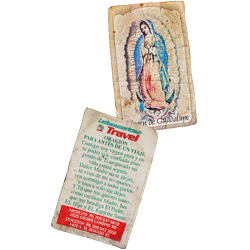
In a secluded part of the Arizona wilderness, illegal immigrants have made a shrine where they pray for safety on their journey into the United States. Among the artifacts they leave behind are prayer cards, which honor the Virgin of Guadalupe and Santo Toribio Romo, the saint who watches over migrants.
(Michael Wells)
On a sweltering June morning, Jason De Leon shrugs off his pack in a rugged gorge in Arizona's Coronado National Forest. He hunches down over a scattering of water bottles, checking for dates, and asks a student to take the site's GPS coordinates. Above his head, along the rock face, travelers have transformed a small, secluded hollow into a shrine lined with offerings: rosaries, crucifixes, candles, scapulars, and small pictures of saints, each bearing a printed prayer in Spanish. "Take care of me in dangerous places," reads one card. "Protect me from thieves and in evil times," entreats another. Nearby, a small engraved plastic pendant offers a more direct prayer: "The other side, Tucson, Arizona, 2010."
The shrine, says De Leon, an archaeologist at the University of Michigan-Ann Arbor, is archaeological evidence of a large and nearly invisible migration. Over the past decade, millions of migrants from Mexico, Guatemala, and other Latin American countries have risked their lives attempting to cross the waterless expanses of the Sonoran Desert to secretly enter the United States. The Department of Homeland Security estimates that 10.8 million illegal migrants were living in the U.S. in 2009. Although this is down from 11.6 million in 2008, these migrants are following a trend that has persisted throughout human history. People move to the place where they can make the best living possible. Last year alone, U.S. Customs and Border Protection authorities apprehended some 540,000 would-be migrants along the Southwest border. Statistics gathered by the U.S. Border Patrol and local coroners' offices suggest that this migration route is growing more dangerous.
Already De Leon's growing database is providing answers. By mapping and dating migrant sites, his team has revealed a strong correlation between recent American government policies and the increasing perils faced by migrants. As the Border Patrol has stepped up its surveillance along the Southwest border, migrants are crossing through ever more isolated and dangerous terrain in hopes of avoiding capture. "It's getting harder and harder to cross all the time," says De Leon. "The migrants are having to walk longer and go into more remote areas."
Understanding the process of making the journey across the border has been difficult because researchers are unable to accompany the migrants on their trips. But two years ago, De Leon decided to look at the issue in a new way—through archaeology. Trekking remote corners of what Border Patrol officials call the Tucson Sector (262 miles of border running west from the New Mexico state line to the Yuma county line), De Leon and a small team are now mapping and dating migrant sites, analyzing artifacts, and gathering detailed ethnographic data on the journey from those who were apprehended. "There are just so many myths about what is going on out there in the desert," says De Leon. "This is a scientific attempt to ground the process in reality, to get as complete a picture as possible."
Archaeologists not affiliated with the project call De Leon's work in the desert both impressive and groundbreaking. "He hasn't drawn a conclusion for which he now wishes to gather data," says Fred Limp, an archaeologist at the University of Arkansas, Fayetteville, and president-elect of the Society for American Archaeology. "He's really trying to understand this migration and the sites he's got."
In a shallow ravine just a few miles outside the small town of Arivaca in southern Arizona, De Leon surveys a site his team has named Buster's Wash. All along the ground, as far as the eye can see, is a tangle of trash: water bottles, jeans, T-shirts, photos, children's toys, toothbrushes, pill packets, hair-gel jars, and—more than any other item—backpacks. It's one of thousands of such sites in the Southwest where migrants led by human smugglers known as coyotes rested on their journey northward. Most Arizona residents, says De Leon, see these sites as garbage dumps.
But De Leon sees the trash heaps differently—as archaeological sites packed with data. So the 33-year-old archaeologist and his students are scouring the backcountry around Arivaca, recording these sites and collecting artifacts before local citizens clean them up.
De Leon is the grandson of an undocumented Mexican migrant, but he first became interested in the archaeology of illegal immigration during the 2007 excavation of an Olmec site in Mexico where he was working as a graduate student. All the local workmen, he explains, "had either migrated at one point, or were getting ready to migrate. So I began talking to them about the things that had happened." The workmen's stories stuck with De Leon. So he began looking around for a way to study this migration.
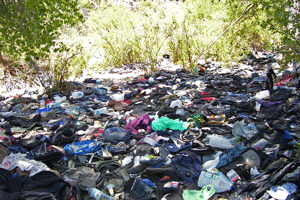
Migrants stop at sites such as Buster's Wash to change clothes and discard any evidence of their illegal border crossings.
(Courtesy Robert Kee; Photo: Michael Wells)

De Leon's team maps the location of each artifact left behind by migrants as they stop to rest on their way to the U.S.
(Courtesy Robert Kee; Photo: Michael Wells)
Archaeologist friends had told him about all the refuse in the Sonoran Desert. Intrigued, De Leon contacted a local humanitarian group, Samaritan Patrol, in Tucson, and arranged to accompany volunteer Bob Kee on a hike. The migrants, Kee told him, are never able to carry enough water to see them through a crossing. So the Samaritans and other groups leave bottled water along high-traffic routes, hoping to save lives. They also scrawl the date and GPS coordinates of the drop site on the sides of the bottles—data they track in order to determine which trails are active, which aren't, and where water is most needed.
The Samaritans' bottles often end up in the migrant rest sites, and therefore the bottles would tell archaeologists where the migrants had been and when they had been there. As De Leon walked some of the sites on that initial trip, he spotted other important temporal clues—dated bus tickets, deportation slips, time-stamped photographs. All this information, he realized, would help an archaeological team study changes in the migrants' routes and behavior over time, something no one had ever done before.
At Buster's Wash just outside Arivaca, the heat pours down like molten metal. Mopping his brow with a handkerchief, De Leon reaches for his water bottle. As migrant sites go, Buster's Wash is small enough that De Leon asks the team to collect everything lying on the ground—a 100 percent sample that effectively erases the site and goes against accepted archaeological protocols. "My rationale for doing this," he says, "is if we don't take it, someone else will, and it will go straight into the trash." He is more selective, however, at larger sites, taking only essential data: clothing that indicates the gender of migrants, new types of gear that reveal shifting patterns in migrant behavior, and backpacks that yield a rough count of the number of migrants at a site. "I think one backpack equals one person," De Leon says. He looks around. "I'd say there's a couple of thousand here."
The site brims with telling details about the journey. In places strewn with empty food tins and black plastic sheets used for bedding, people clearly slept for a few hours and prepared simple meals of tortillas and refried beans. "Here you see a full range of things," says De Leon, "because it's close to a road." At smaller sites next to cattle tanks, they stopped briefly to fill up their water bottles. But at Buster's Wash, he says, migrants changed out of dirty travel clothes and into something clean. They combed and fixed their hair, brushed their teeth, and discarded torn and stained packs that could mark them as migrants. Then they waited in the wash for someone to come pick them up and drive them into Tucson.
Since the September 11 attacks in 2001, the American government has more than doubled its budget for border protection and immigration enforcement, from $7.5 billion to $17 billion, and tripled the number of Border Patrol agents. It has constructed nearly 150 miles of steel fencing and concrete vehicle barriers along the Mexican border, largely in urban areas, purchased drones for aerial surveillance, and built a virtual fence—a string of towers bristling with radar, thermal imaging, and other sensor technologies—to detect migrants moving along 28 miles of the Arizona border. "We've got more technology than ever before watching the border," says Agent Colleen Agle, a public information officer in the Tucson Sector of the Border Patrol. And in her view, the increased surveillance has deterred large numbers of would-be migrants. "People know that when they try to cross the border, they are going to get apprehended," she says.
What De Leon's research provides is a nuanced picture of the migrants' response to this strategy. Before the stepped-up border surveillance, most migrants crossed through border cities—a relatively safe proposition. But after 2001, says De Leon, the U.S. government greatly boosted the number of Border Patrol agents in the cities along the Mexican border, effectively sealing off the old urban routes. So migrants began crossing, instead, through the Sonoran Desert. And De Leon has discovered a disturbing trend in his data: the more recent the migrant site is, the smaller and more remote it tends to be. To evade detection by drones and virtual fences, coyotes are leading smaller parties through increasingly isolated and dangerous terrain. "Now these guys are scaling rock cliffs," says De Leon. "And it hasn't always been like that. It used to be much easier."
Randall McGuire, a Binghamton University archaeologist who has worked along the Southwest border since 1985, says this data fits well with hundreds of conversations he has had with returned migrants in northern Mexico. "In 1985," says McGuire, "people had to walk just a few hours to get across the border. In 2006, people were walking for three days through the Sonoran Desert. Now, due to increased enforcement, they are walking five days. And there's just no physical way to carry water enough for even a three-day trip."
Colleen Agle says that the Border Patrol is doing everything it can to assist migrants who fall into trouble on these long treks. It has specially trained Border Patrol Search, Trauma, and Rescue teams for medical emergencies in the desert and has placed them in every sector along the Southwest border. "Their entire mission is to go out and save people, particularly during the hot summer months," Agle says.
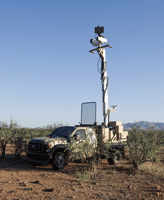
The U.S. Border Patrol is increasing its use of technology such as radar and thermal imaging to apprehend people crossing the border illegally.
(Courtesy Jason de Leon; Photo: Michael Wells)
Increasingly, says De Leon, evidence shows the ways in which the migrants are adapting to the perils. In sites dated to 2007, De Leon found an abundance of high-heeled shoes, blow-dryers, and other heavy, bulky items, suggesting that the trekkers had little idea of the type of journey they were taking. But few of these items are found at later sites. By 2009, migrants were carrying little extra weight and were dressing in more suitable clothing, including hiking boots and camouflage gear. Moreover, many were dispensing with clear plastic water bottles that could reflect the headlights of Border Patrol trucks. A year or so ago, they began carrying a new type of plastic water bottle manufactured in Mexico: it's solid black, to help them
hide at night.
For De Leon, the artifacts clearly reveal how migrants and their Mexican suppliers are constantly adapting to the harsh new realities of the journey to El Norte. "I think everyone knows that this is going to be a really bad experience," he says. "But a lot of people are wondering, 'How can I be smarter during the whole process?'"
The whole notion of regarding and classifying water bottles and blow dryers as archaeological artifacts can initially seem like something of a stretch. But, in fact, the evidence of mass migrations, in more traditional terms, can reside in the artifacts that are brought along and shared. The clash and blending of cultures is often documented by finding the blending of artifact styles—from that of the local inhabitants and that of the migratory population. To document this current migration we need to look at artifacts from our own time.
While De Leon's work in the Sonoran Desert exposes the deadly consequences of sealing off the old urban migration routes, it does not reveal much about the experiences of individual migrants. To record these experiences, De Leon has been traveling to the Mexican border town of Nogales to interview newly returned deportees. On a quiet summer evening there, he chats with Hilda Irene Loureido, one of the founders of Albergue San Juan Bosco, a former church turned migrant shelter. For more than a quarter of a century, Loureido and her husband, Juan Francisco, have strung meager funds together to keep the facility open. It's a modest operation, but the shelter is immaculate, with clean bunks and bedding, scrubbed-out toilets, and a hot meal for newly deported migrants, each of whom is allowed to stay three days.
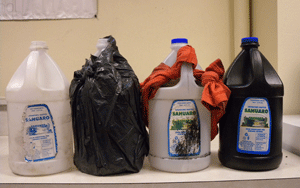
White water bottles are easily seen at night, so migrants often put covers on them. Some bottlers have begun manufacturing black bottles to appeal to migrants.
(Courtesy Jason de Leon; Photo: Michael Wells)
"Tonight is relatively quiet," says Loureido. As a rule, American authorities deport migrants to the nearest Mexican border city. But during the summer, they fly those they catch to Mexico City, 1,000 miles to the south, as an additional deterrent to a future crossing attempt. Tonight, just 30 to 40 migrants have arrived at the shelter, a far cry from the 250 or so who typically crowd into its beds. But it's still early, only 10 p.m., and American authorities have a habit of deporting people in the early morning hours, a dangerous time of day to drop off exhausted migrants in crime-ridden Nogales. De Leon suspects that this is a deliberate strategy—one more deterrent to a future crossing.
The migrants, who are unwilling to divulge their names to a journalist, have varying reasons for undertaking the journey to the United States. "Some people do this for money, some do it to buy a big car," says a small man with dark shadows under his eyes and a rueful smile. "But I have a large family to support in Mexico and that's a burden I will have to carry all my life." To make more money for his family, he explains, he followed a sister to Wisconsin where she had opened a small restaurant. Living there quietly, he managed to escape detection until he was apprehended on a driving charge and subsequently deported. Last week, he says, he attempted to cross the desert, an experience he found terrifying. "Unless you've tried to do it," he says grimly, "you'll never know what it's like out there. But I have to try again. I have three kids in the United States."
First-time migrants, says De Leon, often make arrangements ahead of time with known coyotes in their home villages in Mexico and Central America, paying thousands of dollars for a crossing. But those who have been apprehended and deported sometimes head back out on their own or hire cut-rate smugglers operating out of Mexican border towns. The migrants making the journey again prepare as best they can, shopping in Nogales's small street kiosks lined with specialized gear—camouflage packs, dark clothing, and bottles of Electrol"t, the Mexican equivalent to Gatorade.
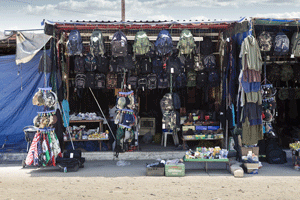
Outfitting migrants for their journeys through the desert has become a booming business in towns on the Mexican side of the border.
(Courtesy Jason de Leon; Photo: Michael Wells)
Some migrants barely make it out of the border towns before criminals known as bajadores descend on them, demanding their money and often physically and sexually assaulting them. "They lined us up and had us fill a plastic bag with all of our valuables," one migrant told De Leon. "They had cuernos de chivos (literally translated as "goat's horns," an expression meaning "machine guns"). It was clear the coyote knew this was going to happen." For others, the most harrowing ordeal begins farther north. The coyotes insist that migrants move as quickly as possible, and to keep their exhausted charges on the march, they hand out ephedrine-based pills. The drug boosts the metabolism and heart rates of the slowest walkers, but the end result is dehydration, prompting migrants to empty the water bottles
they are carrying.
For the lucky ones who make it through the desert, however, there is little freedom from worry. The Border Patrol has a large and visible presence in most Southwest cities. "If you ask the migrants where they are going, it's never Tucson or Los Angeles," says De Leon. "It's always Eugene, Oregon; Spokane, Washington; or Sheboygan, Wisconsin." There, many gravitate to jobs in rendering plants and other undesirable work in the food processing industry that pays $11 to $14 dollars an hour.
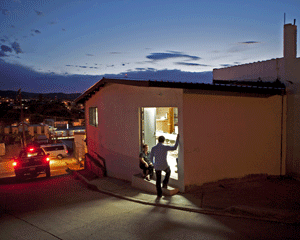
Migrants who are caught by the U.S. Border Patrol are sometimes deported in the early morning hours and dropped off in border towns such as Nogales. Migrant safe houses have sprung up there.
(Photo: Michael Wells)
The hope of finding employment remains a powerful incentive for migration, particularly among rural Mexicans whose family incomes have been devastated in recent years by forces beyond their control. In 1994, Mexico entered into the North American Free Trade Agreement with the United States and Canada. The treaty permitted American farmers to ship cheap, federally subsidized corn and wheat into the Mexican market.
All this has left rural Mexicans poorer than ever. Many of their homes fail to meet even minimum standards of sanitation, according to statistics compiled by the World Bank and other nongovernmental organizations, and their children spend fewer than four years in school. Many young Latin Americans feel as if they have little to lose by attempting to migrate to the United States.
The financial downturn that began in 2007, says Robert Topel, an economist at the University of Chicago, has made jobs much harder to find north of the border and probably given many would-be migrants pause. According to the Department of Homeland Security, a combination of the declining economy and tougher enforcement efforts has caused the number of illegal migrants apprehended by the Border Patrol to drop from 1,189,000 in 2005 to 724,000 in 2008. But even so, the prospect of a new life in the United States remains attractive. "It goes beyond the wages they can earn [here]," says Topel. "They can probably get decent educations for their kids. They get access to health care, and even just with emergency rooms, it's probably much better than what they can get back home in a poverty-stricken Mexican village."
For those who have studied earlier waves of migration to the United States, the situation sounds all too familiar. Stephen Brighton, an archaeologist at the University of Maryland, College Park, has been examining the massive nineteenth-century Irish migration to the United States.
Between 1845 and 1850, explains Brighton, blighted crops of potatoes left tenant farmers with few options except selling off their livestock to support their families. With no livestock, the farmers ended up destitute and facing a choice between starving in Ireland or migrating to America. Most of the Irish who landed on American shores at that time were desperately poor and uneducated—much like the Mexican migrants of today. "There are a lot of parallels," says Brighton.
But as these Irish immigrants sank roots in American society, their descendants prospered and became part of the essential fabric of American life. De Leon thinks the very same thing will happen to the undocumented Mexican migrants of today. "At some point, Mexican-Americans will want to say to their children, this is what I went through. This is how I got here," he says. And when that day finally comes, the backpacks, the clothing, the children's toys collected from Buster's Wash, will preserve this shadowy history of migration, reminding the future of what has been.
Heather Pringle is a contributing editor at ARCHAEOLOGY.
Advertisement

Advertisement







